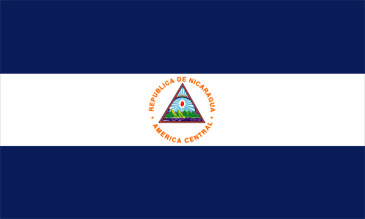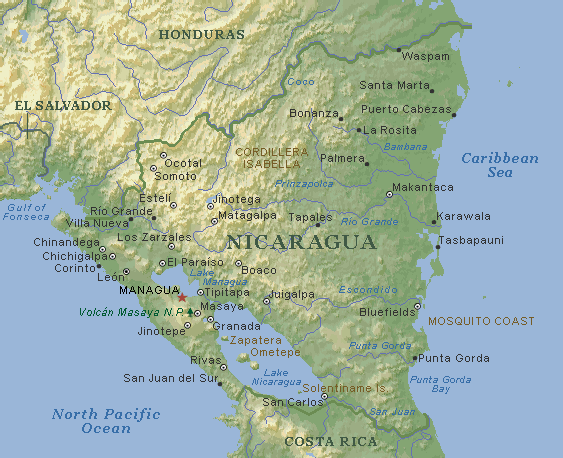|
NAME: República
de Nicaragua; country named for Chief Nicaraoa when Spanish arrived in 1524;
or "nicarao" (> name
of Náhuatl-speaking tribe living on the shores of Lake Nicaragua; the
ending "agua" was possibly added by the Spanish for the water (agua =
water) in the region; however, this latter is most likely just a popular
etymology.
POPULATION: 4,300,000
(1997); 5,700,000 (2007); 6,500,000 (2014)
ETHNIC
GROUPS: Mestizo
(69%); white (17%); black (9%); Indian (5%)
CAPITAL: Managua
(2,200,000 population–2014)
LANGUAGES: Spanish
(official); Indian languages
RELIGION: Roman
Catholicism (95%)
LIFE
EXPECTANCY: 1997:
men (63); women (68); 2007: men, 69; women, 73
LITERACY: 1997:
66%; 2007: 67%
GOVERNMENT: democratic
republic
President: Daniel
Ortega Saavedra (since 2007)
MILITARY: 12,000
active troops
ECONOMY: oil
refining, bananas, cotton, fruit, coffee
MONEY: gold
córdoba (NIO); 1997: 8.4 = $1.0 USD; 2007: 17.6 NI) / 1.0 USD
GEOGRAPHY: both
Atlantic and Pacific coasts are over 200 miles long;
INTERNET CODE: .ni
HISTORY:
6000
BCE Evidence
of native inhabitants
700
BCE – 1425 CE Various
tribes, first Maya, then Chibcha (Colombia) inhabit the region of present-day
Nicaragua
1425-1524
Part
of Aztec Empire
1502
1524-1552 Settled
and conquered by
1524-1858 Capital
at León; thereafter at
1821
1825-1840
1852-1933 US
Marines land/invade 14 times
1855-1860 William
Walker (American) attempted to establish control over
1909
1912
1916-1926 Instability
under conservative presidents
1926
(May 2) Gen.
Agusto César Sandino starts insurrection after Gen. Moncada agrees with
1933 Sandino
killed by Anastasio Somoza's National Guard
1936-1956 Anastasio
Somoza (senior) dictator
1956-1967 Luis
Somoza dictator (dies of heart attack), brother of Anastasio Somoza Debayle
1967-1979 Anastasio
Somoza Debayle (junior), dictator (started as elected president, then
“elected” again 1974)
1972 Earthquake
kills 13,000 and destroys 80% of buildings in
1972-1979 Frente
Sandinista de Liberación Nacional (FSLN) wages guerrilla war
1978 Pedro
Joaquín Chamorro (editor of La
Prensa ) assassinated by National Guard (husband to Violeta Barrios de
Chamorro)
1979 Dictator
Anastasio Somoza Debayle overthrown by Sandinistas
Land
Reform Law passed; 1979-84, 3,476,627 acres distributed to 54,252 families
1980 Somoza
assassinated in
1984 CIA
mines Nicaraguan ports
Daniel
Ortega Saavedra (Sandinista) elected president
1985 Sandinistas
sign accord with Miskito Indians
1987 Aug.
7: Signed Treaty with 5 Central American countries in
Nov.
6: Appointed Miguel Cardinal Obando y Bravo to mediate peace with Contras ; effort failed
1988 Jan.:
Negotiations with contras begin; Feb. U.S. cuts off aid to contras ; effort failed
1989 Feb.
14: Signed new treaty with 5
Central American countries to liberalize press and elections in exchange for
dismantling the contras
Mar.
25: Pres. George Bush (
Aug.
4: Agreement between all political
parties and Sandinistas to hold elections on Feb. 25, 1990 and to eliminate all
foreign support for contras
1990–2006 Feb.
25: Unión Nacional de la
Oposición (UNO) wins elections: Violeta Barrios de Chamorro elected
president with 55% of vote; takes office April 25, 1990; defeated Daniel Ortega
2007–2017 Daniel
Ortega elected president twice
GOVERNMENT:
PRESIDENT: Daniel
Ortega
MAJOR POLITICAL PARTIES AND POWER GROUPS:
Frente Sandinista, leader Daniel Ortega Saavedra
Partido
Conservador de Nicaragua
Partido
Liberal Constitucionalista
Partido
Liberal Independiente, president Virgilio Godoy Reyes
Partido
Popular Socialcristiano, president Mauricio Díaz Dávila
Partido
Socialcristiano
Partido
Socialdemócrata y Comunista de Nicaragua
Roman
Catholic Church, Miguel Cardinal
Obando y Bravo
Unión Nacional de la Oposición (UNO;
coalition of 14 parties opposed to Sandinistas)
PRINCIPAL
MEMBERS OF INTELLIGENTSIA:
Rubén
Darío (1867-1916), national poet laureat; Modernist: Azul (1888), Prosas profanas (1897), Cantos
de vida y esperanza (1903)
Ernesto
Cardenal, poet: En Cuba (1972), Homenaje a los indio americanos, Quetzalcóatl (1989)
Sergio
Ramírez, short stories, essays, biography, novel: Tiempo de fulgor (1970)
Cristina
Chamorro Barrios: editor of La Prensa

